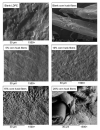Biodegradability of Polyolefin-Based Compositions: Effect of Natural Rubber
- PMID: 35160520
- PMCID: PMC8838498
- DOI: 10.3390/polym14030530
Biodegradability of Polyolefin-Based Compositions: Effect of Natural Rubber
Abstract
Recently, environmental problems caused by the overproduction and consumption of synthetic polymer materials led to an urgent need to develop efficient methods for processing plastics. The accumulation of polymer waste for their subsequent incineration does not solve the problem due to the limited areas of landfills for waste storage. In addition, the incineration of polymer waste can cause toxic air pollution, which, in turn, does not contribute to an improvement in the environmental situation. Recycling plastics, although a more environmentally friendly waste disposal method, requires significant labor and energy costs and can be performed a limited number of times. Thus, the most promising solution to this problem is the creation of biodegradable polymers capable of degradation with the formation of simpler chemical structures (water, carbon dioxide, biomass, etc.), which are easily included in the metabolic processes of natural biological systems. The article provides an overview of the main trends in the creation of biodegradable composites for the needs of agriculture. Also, the article proposes a new composition based on polyethylene with natural rubber that surpasses existing biodegradable materials in a number of physical and mechanical characteristics and has the ability to complete biodegradation in 60 months. It is shown that the studies carried out to date indicate that these composites are highly promising for the creation of biodegradable packaging materials with good performance characteristics. Thus, it was concluded that further research on composites based on polyethylene and natural rubber is important.
Keywords: biodegradation; life cycle; natural rubber; polyethylene.
Conflict of interest statement
The authors declare no conflict of interest.
Figures










References
-
- Litvyak V.V. Prospects for the production of modern packaging materials using biodegradable polymer compositions. [(accessed on 9 November 2019)];J. Belarusian State Univ. Ecol. 2019 2:84–94. Available online: https://journals.bsu.by/index.php/ecology/article/view/2711. (In Russian)
-
- Jaserg B., Swanson C., Nelsen T., Doane W. Mixing polyethylene-poly(ethylene-co-acrylic acid) copolymer starch formulations for blown films. J. Polym. Mat. 1992;9:153–162.
Publication types
LinkOut - more resources
Full Text Sources

